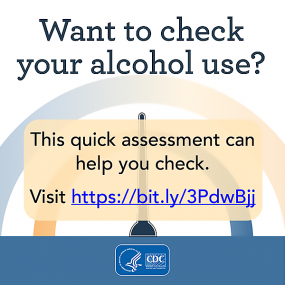Binge Drinking
Binge drinking is a serious but preventable public health problem.
Binge drinking is the most common and costly pattern of excessive alcohol use in the United States.1,2 Binge drinking is defined as consuming 5 or more drinks on an occasion for men or 4 or more drinks on an occasion for women.
Most people who binge drink are not dependent on alcohol.3 However, binge drinking is harmful on its own. It is associated with serious injuries and diseases, as well as with a higher risk of alcohol use disorder.3
How common is binge drinking?
- One in six US adults binge drinks, with 25% doing so at least weekly.1
- Binge drinking is just one pattern of excessive drinking, but it accounts for nearly all excessive drinking. Over 90% of US adults who drink excessively report binge drinking.3
Who binge drinks?1
- Binge drinking is most common among younger adults aged 18–34.
- Binge drinking is more common among men than among women.
- Binge drinking is most common among adults who have higher household incomes ($75,000 or more), are non-Hispanic White, or live in the Midwest.
- For some groups and states, binge drinking is not as common, but those who binge drink do so frequently or consume large quantities of alcohol.
How many binge drinks are consumed?
- One in four US adults who binge drink consume at least eight drinks during a binge occasion.1
- Overall, 17 billion total binge drinks are consumed by adults annually, or 467 binge drinks per adult who binge drinks.4
- Four out of five binge drinks are consumed by men. 4
- More than half of binge drinks are consumed by adults 35 and older. 4
- People with lower incomes and lower levels of education consume more binge drinks per year.4
- Most people younger than 21 who drink alcohol report binge drinking, often consuming large amounts. Among high school students who binge drink, 44% consumed eight or more drinks in a row.5,6
Binge drinking has serious risks.
Binge drinking is associated with many health problems,7–9 including:
- Unintentional injuries such as motor vehicle crashes, falls, burns, and alcohol poisoning.
- Violence including homicide, suicide, intimate partner violence, and sexual assault.
- Sexually transmitted diseases.
- Unintended pregnancy and poor pregnancy outcomes, including miscarriage and stillbirth.
- Fetal alcohol spectrum disorders.
- Sudden infant death syndrome.
- Chronic diseases such as high blood pressure, stroke, heart disease, and liver disease.
- Cancer of the breast (among females), liver, colon, rectum, mouth, pharynx, larynx, and esophagus.
- Memory and learning problems.
Read more about the CDC study that found that excessive drinking in the U.S is a drain on the American economy.
Binge drinking costs everyone.
- Excessive drinking, including binge drinking, cost the United States $249 billion in 2010, or $2.05 per drink. These costs were from lost work productivity, health care expenditures, criminal justice costs, and other expenses. Binge drinking accounted for 77% of these costs, or $191 billion.2
The Community Preventive Services Task Force recommends evidence-based interventions to prevent binge drinking and related harms. Recommended strategies include:
- Using pricing strategies, including increasing alcohol taxes.
- Limiting the number of retail alcohol outlets in a given area.
- Holding alcohol retailers responsible for the harms caused by illegal alcohol sales to minors or intoxicated patrons (dram shop liability).
- Restricting access to alcohol by maintaining limits on the days and hours of alcohol retail sales.
- Consistently enforcing laws against underage drinking and alcohol-impaired driving.
- Maintaining government controls on alcohol sales (avoiding privatization).
The U.S. Preventive Services Task Force also recommends screening and counseling for alcohol misuse in primary care settings.
- Bohm MK, Liu Y, Esser MB, Mesnick JB, Lu H, Pan Y, Greenlund KJ. Binge drinking among adults by select characteristics and state — United States, 2018. MMWR 2021;70:41.
- Sacks JJ, Gonzales KR, Bouchery EE, Tomedi LE, Brewer RD. 2010 national and state costs of excessive alcohol consumption. Am J Prev Med 2015;49:e73–e79.
- Esser MB, Hedden SL, Kanny D, Brewer RD, Gfroerer JC, Naimi TS. Prevalence of alcohol dependence among US adult drinkers, 2009–2011. Prev Chronic Dis 2014;11:140329.
- Kanny D, Naimi TS, Liu Y, Lu H, Brewer RD. Annual total binge drinks consumed by U.S. adults, 2015. Am J Prev Med 2018;54:486–496.
- Jones CM, Clayton HB, Deputy NP, et al. Prescription opioid misuse and use of alcohol and other substances among high school students — Youth Risk Behavior Survey, United States, 2019. MMWR Suppl 2020;69(Suppl-1):38–46.
- Esser MB, Clayton H, Demissie Z, Kanny D, Brewer RD. Current and binge drinking among high school students – United States, 1991–2015. MMWR 2017;66:474-476.
- World Health Organization. Global Status Report on Alcohol and Health—2018. Geneva, Switzerland: World Health Organization; 2018.
- Naimi TS, Lipscomb LE, Brewer RD, Colley BG. Binge drinking in the preconception period and the risk of unintended pregnancy: Implications for women and their children. Pediatrics 2003;11:1136–1141.
- Iyasu S, Randall LL, Welty TK, et al. Risk factors for sudden infant death syndrome among northern plains Indians. 2002;288:2717–2723.
